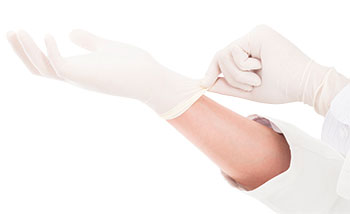Hands are recognized as a major vehicle for transmission of infection in both the healthcare and the spa or clinic settings. It is necessary for good hygiene practices to be in place so they can interrupt any transmission of micro-organisms. Good hygiene can also remove micro-organisms acquired after touching a client. These procedures are very simple and spa professionals can use soap and water and do a thorough cleansing of hands and lower arms; or, they can use an alcohol hand gel.
When it comes to gloves, different gloves are used in different settings, depending on direct and indirect exposure. Sterile gloves are required for chemotherapy infusion settings and other medical settings and do not include spas. Examination gloves are necessary in clinical settings, which include spas, for direct exposure – direct contact with client’s blood, mucous membranes, and skin which is not intact (extractions, hair removal, tattooing); and indirect exposure – cleaning waste (gauze, cotton swabs, cotton pads) and cleaning of any re-usable implements. Gloves are not necessarily indicated as necessary in clinical settings, which include spas, for direct exposure – applying services where no secretions are given, plus no breaks in the skin (makeup, massage); and indirect exposure – making appointments via phone, computer, or book, changing linens on a table or bed, and moving equipment in the spa or salon.
 The decision to wear gloves can be influenced by the professional’s emotions or due to professional, organizational, or empathetic socialization.
The decision to wear gloves can be influenced by the professional’s emotions or due to professional, organizational, or empathetic socialization.
Professional socialization includes: professionals following procedures of peers; previous training to use gloves; previous experience in which gloves prevented a dire situation; and wearing gloves due to habit.
Organization socialization includes professionals adhering to spa policies, availability of gloves, and attitudes about glove wearing.
Empathetic socialisation includes the professional who feels that gloves create a barrier when they cannot touch the client’s skin. There is also the feeling that the client may feel the professional sees them as dirty.
Emotions are a powerful drive for wearing gloves due to professional risks and disgust or fear and sense of safety.
A professional may have thoughts pertaining to their risk so, when they touch a client, they want to protect themselves, or both them and the client, or they may have thoughts about what disease or infection they may get from a client if they do not wear gloves. Another thought a professional could have is that, by wearing gloves, this could eliminate the amount of times they need to wash their hands.
A professional may have thoughts pertaining to disgust or fear and their sense of safety, such as if the client has a skin condition that is unsightly or unfamiliar, that may prompt them to wear gloves. Or, the professional may feel that gloves make them feel safer, relaxed, comfortable, and more confident to perform a service.
Gloves can provide a psychological barrier. A professional could feel that if they do not use gloves it would be a bit awkward when working in the client’s personal areas (Brazilian waxing); or, the professional could feel they have built up such a good relationship with the client that they feel that wearing gloves seems impersonal.
Universal precautions (1987) were created in response to HIV to protect a person from acquiring blood borne viruses (BBV) via damaged skin – to avoid direct contact with blood and body fluids from patients.
Standard precautions (mid-1990s) brought about gloves in routine clinical care and to serve a dual purpose to protect against BBV and to reduce the risk of transmission of pathogens from blood and body fluid (BBF). These guidelines include:
- wearing clean, single-use, disposable gloves
- changing gloves between clients or services (when performing separate procedures on the same client where there is a risk of transfer of infectious agents from one part of the body to another)
- changing gloves as soon as they are torn or punctured or when unsterile items or surfaces are touched
- cleaning hands before putting on and after removing gloves
- inspecting gloves before each use and throwing them away if peeled, cracked, discolored, torn, or punctured because gloves can have defects such as tiny holes, even when they are new, or can be damaged while in use or in storage
Ultimately, there are several emotional, social, habitual, and other factors, that may influence a professional in his or her desire to wear gloves during treatments. As professionals research and strive to adhere to universal safety precautions and guidelines, as well as maintain proper hygiene practices, they will be better able to decide for themselves when to glove or not to glove.